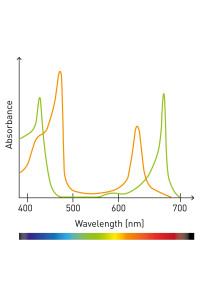UV-VIS Anti-Elastase Assay (SANA)
- Product Code: 31937
UV-VIS Anti-Elastase Assay (SANA)
UV-VIS Anti-Elastase Assay (SANA, 1 sample)
An anti-elastase assay using UV-Vis spectrophotometry measures the ability of a substance to inhibit the activity of the enzyme elastase. Elastase is an enzyme that breaks down elastin, a protein in connective tissues. Inhibitors of elastase are of interest in various fields, including pharmaceuticals and cosmetics. Here's a general protocol for conducting an anti-elastase assay using UV-Vis spectrophotometry:
Materials and Reagents:
Elastase enzyme
Substrate solution (e.g., N-succinyl-Ala-Ala-Ala-p-nitroanilide)
Inhibitor substance or sample extract
Appropriate buffer solution (e.g., Tris-HCl buffer, pH 8)
Deionized water
Positive control inhibitor (optional)
Pipettes and pipette tips
Test tubes or microcentrifuge tubes
Vortex mixer or shaker
Timer or stopwatch
Lint-free tissue for cuvette cleaning
Procedure:
Prepare a Blank Solution:
Use a UV-grade quartz cuvette and fill it with the buffer solution (without any inhibitor or elastase). This will serve as your blank reference for baseline correction.
Calibrate the Spectrophotometer:
Turn on the UV-Vis spectrophotometer and allow it to warm up.
Set the wavelength to the appropriate value for monitoring the enzymatic reaction. The exact wavelength will depend on the substrate used (e.g., p-nitroanilide at 410 nm).
Adjust the spectrophotometer's baseline using the blank solution, so that it reads zero absorbance at the chosen wavelength.
Prepare the Reaction Mixture:
In a test tube or microcentrifuge tube, mix the following components in the specified order:
A known volume of elastase enzyme solution
A known volume of substrate solution
A known volume of inhibitor substance or sample extract
Buffer solution to reach the desired total volume
Ensure that the enzyme and substrate concentrations are consistent between experiments.
Incubate the Reaction Mixture:
Incubate the reaction mixture at an appropriate temperature (typically around 37°C) for a specific amount of time. The incubation time may vary depending on the enzyme kinetics and the specific assay conditions.
Measure Absorbance:
After the incubation, take a small volume (usually 1 mL) of the reaction mixture and transfer it to a quartz cuvette.
Wipe the cuvette with a lint-free tissue to remove any fingerprints or smudges.
Place the cuvette in the spectrophotometer and record the absorbance at the chosen wavelength.
Calculate Elastase Inhibition Percentage:
Compare the absorbance of the sample with the inhibitor to the control sample without the inhibitor (blank)
| ขั้นตอน | ขั้นตอน | ผลลัพธ์ที่คาดหวัง | |||
|---|---|---|---|---|---|
| ไม่มีรายการที่จะแสดง | |||||
UV-VIS Anti-Elastase Assay (SANA)
UV-VIS Anti-Elastase Assay (SANA, 1 sample)
An anti-elastase assay using UV-Vis spectrophotometry measures the ability of a substance to inhibit the activity of the enzyme elastase. Elastase is an enzyme that breaks down elastin, a protein in connective tissues. Inhibitors of elastase are of interest in various fields, including pharmaceuticals and cosmetics. Here's a general protocol for conducting an anti-elastase assay using UV-Vis spectrophotometry:
Materials and Reagents:
Elastase enzyme
Substrate solution (e.g., N-succinyl-Ala-Ala-Ala-p-nitroanilide)
Inhibitor substance or sample extract
Appropriate buffer solution (e.g., Tris-HCl buffer, pH 8)
Deionized water
Positive control inhibitor (optional)
Pipettes and pipette tips
Test tubes or microcentrifuge tubes
Vortex mixer or shaker
Timer or stopwatch
Lint-free tissue for cuvette cleaning
Procedure:
Prepare a Blank Solution:
Use a UV-grade quartz cuvette and fill it with the buffer solution (without any inhibitor or elastase). This will serve as your blank reference for baseline correction.
Calibrate the Spectrophotometer:
Turn on the UV-Vis spectrophotometer and allow it to warm up.
Set the wavelength to the appropriate value for monitoring the enzymatic reaction. The exact wavelength will depend on the substrate used (e.g., p-nitroanilide at 410 nm).
Adjust the spectrophotometer's baseline using the blank solution, so that it reads zero absorbance at the chosen wavelength.
Prepare the Reaction Mixture:
In a test tube or microcentrifuge tube, mix the following components in the specified order:
A known volume of elastase enzyme solution
A known volume of substrate solution
A known volume of inhibitor substance or sample extract
Buffer solution to reach the desired total volume
Ensure that the enzyme and substrate concentrations are consistent between experiments.
Incubate the Reaction Mixture:
Incubate the reaction mixture at an appropriate temperature (typically around 37°C) for a specific amount of time. The incubation time may vary depending on the enzyme kinetics and the specific assay conditions.
Measure Absorbance:
After the incubation, take a small volume (usually 1 mL) of the reaction mixture and transfer it to a quartz cuvette.
Wipe the cuvette with a lint-free tissue to remove any fingerprints or smudges.
Place the cuvette in the spectrophotometer and record the absorbance at the chosen wavelength.
Calculate Elastase Inhibition Percentage:
Compare the absorbance of the sample with the inhibitor to the control sample without the inhibitor (blank)
| Mechanism | - |
| Appearance | - |
| Longevity | - |
| Strength | - |
| Storage | - |
| Shelf Life | - |
| Allergen(s) | - |
| Dosage (Range) | - |
| Recommended Dosage | - |
| Dosage (Per Day) | - |
| Recommended Dosage (Per Day) | - |
| Mix Method | - |
| Heat Resistance | - |
| Stable in pH range | - |
| Solubility | - |
| Product Types | - |
| INCI | - |
Purchase History for
ตะกร้า
ไม่มีสินค้า



